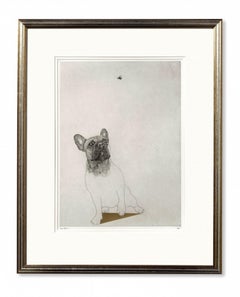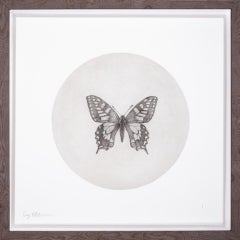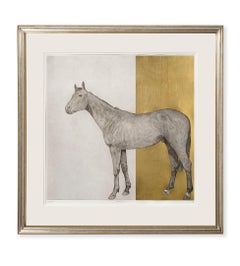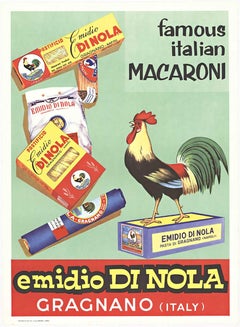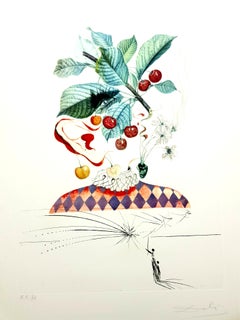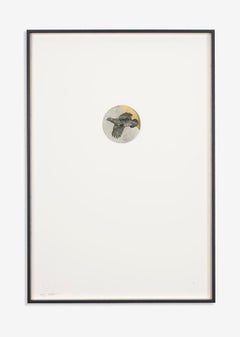Gold Leaf Still-life Prints
to
2
1
Overall Width
to
Overall Height
to
1
1
1
3
2
2
1
1
3
2
1
2
1
1
1
1
7
6
3
3
3
3
Artist: Guy Allen
Medium: Gold Leaf
Libby And Bumblebee, Guy Allen, Limited Edition Print, Animal Art, Black & White
By Guy Allen
Located in Deddington, GB
Please note the price is for the unframed original etching .
Libby and Bumblebee is an original etching, engraved onto a copper plate, from which Guy Allen creates an impression of ink onto paper. To create his pieces, Guy Allen marries the traditional technique of etching with timeless subject matter and print making processes, for a more contemporary twist.
Guy has adopted a unique approach to etching by using a stippling effect on the plate, a labour intensive pointillist technique which gives the images a detailed finish and highlights his skill in freeform drawing and etching.
Image size: 29cm x 40cm
Approximate size when framed: 45cm x 65cm
Medium: Etching and gold leaf
Edition size: 75
Year completed: 2017
Size: H:40 cm x W:29 cm
Accomplished print maker Guy Allen (b.1987) grew up surrounded by Norfolk’s natural beauty. The theme of the animal world is central to Guy’s work and inspiration. His limited edition original etchings showcase his brilliant draftsmanship in a contemporary way. Guy graduated from Central Saint Martins School of Art in 2011, but discovered his passion for the traditional etching process while studying at the École Nationale Supérieure Des Beaux-Arts in Paris in 2010. In 2012 Guy trained as an assistant print maker at the highly respected Curwen Studios, Cambridge, under Mary Dalton and Stanley Jones, where he mastered other types of printmaking. Today Guy works as a full time artist, splitting his week between his London and Norfolk studios, accompanied by trusty wire haired...
Category
21st Century and Contemporary Photorealist Gold Leaf Still-life Prints
Materials
Gold Leaf
Swallowtail Butterfly, Guy Allen, Limited Edition Print, Affordable Animal Art
By Guy Allen
Located in Deddington, GB
Please note the price is for the unframed original etching .
Swallowtail Butterfly is an original etching, engraved onto a copper plate, from wh...
Category
21st Century and Contemporary Minimalist Gold Leaf Still-life Prints
Materials
Gold Leaf
Guy Allen, Equine Gold, Affordable Contemporary Art
By Guy Allen
Located in Deddington, GB
Guy Allen
Equine Gold
Etching, Aquatint and Hand Finished Gold Leaf
Edition Size: 75
Year Completed: 2019
Image Size: H 60cm x W 60cm
Approximate Size When Framed: H80cm xW 80cm
Sold...
Category
21st Century and Contemporary Contemporary Gold Leaf Still-life Prints
Materials
Gold Leaf
Related Items
Original Italian Emidio di Nola Italian Macaroni original vintage food poster
Located in Spokane, WA
Emidio di Nola, original Italian pasta poster. Size 19" x 25.5". Professional acid-free archival linen-backed; in excellent condition; ready to frame....
Category
1950s Aesthetic Movement Gold Leaf Still-life Prints
Materials
Lithograph
$750
H 25.5 in W 19 in D 0.05 in
Salvador Dali - Cherries - Original Hand-Signed Lithograph
Located in Collonge Bellerive, Geneve, CH
Salvador Dali - Cherries - Original Hand-Signed Lithograph
Dimensions: P. 57 x 37 cm
Sheet: 75 x 56 cm
Handsigned
Edition: EC.d (collaborator edition "d")
Excellent Condition
Refer...
Category
1960s Surrealist Gold Leaf Still-life Prints
Materials
Lithograph
$6,229
H 29.53 in W 22.05 in D 0.4 in
The Celestial Hippocampus (Ed. 88/140)
Located in Dallas, TX
"The Scar by China Miéville is a novel which has been a part of my life for many years, and has travelled as my companion through since adolescence. I've attempted to depict the Avan...
Category
21st Century and Contemporary Surrealist Gold Leaf Still-life Prints
Materials
Screen
Frogs and Toad, Signed lithograph (AP), from Conspiracy: The Artist as Witness
By Jack Beal
Located in New York, NY
Jack Beal
Frogs and Toad, 1971
Hand signed in pencil by Jack Beal, annotated AP
One-color lithograph proofed by hand and pulled by machine from a zinc plate on Arches buff paper with deckled edges at the Shorewood Bank Street Atelier
Stamped, hand numbered AP, aside from the regular edition of 150 Stamped on reverse: COPYRIGHT © 1971 BY JACK BEAL, bears blind stamp
18 × 24 inches
Unframed
18 x 24 inches
Stamped on reverse: COPYRIGHT © 1971 BY JACK BEAL, bears distinctive blind stamp of publisher (shown) Publisher: David Godine, Center for Constitutional Rights, Washington, D.C.
Jack Beal's "Frogs and Toads" is a classic example of protest art from the early 1970s - the most influential era until today. This historic graphic was created for the legendary portfolio "CONSPIRACY: the Artist as Witness", to raise money for the legal defense of the Chicago 8 - a group of anti-Vietnam War activists indicted by President Nixon's Attorney General John Mitchell for conspiring to riot during the 1968 Democratic National Convention. (1968 was also the year Bobby Kennedy was killed and American casualties in Vietnam exceeded 30,000.) The eight demonstrators included Abbie Hoffman, Jerry Rubin, David Dellinger, Tom Hayden, Rennie Davis, John Froines, Lee Weiner, and Bobby Seale. (The eighth activist, Bobby Seale, was severed from the case and sentenced to four years for contempt after being handcuffed, shackled to a chair and gagged.) Although Abbie Hoffman would later joke that these radicals couldn't even agree on lunch, the jury convicted them of conspiracy, with one juror proclaiming the demonstrators "should have been shot down by the police." All of the convictions were ultimately overturned by the 7th Circuit Court of Appeals.
This lithograph has fine provenance: it comes directly from the original Portfolio: "Conspiracy The Artist as Witness" which also featured works by Alexander Calder, Nancy Spero and Leon Golub, Romare Bearden Sol Lewitt, Robert Morris, Claes Oldenburg, Larry Poons, Peter Saul, Raphael Soyer and Frank Stella - as well as this one by Jack Beal. It was originally housed in an elegant cloth case, accompanied by a colophon page. This is the first time since 1971 that this important work has been removed from the original portfolio case for sale. It is becoming increasingly scarce because so many from this edition are in the permanent collections of major museums and institutions worldwide.
Jack Beal wrote a special message about this work on the Portfolio's colophon page. It says, "In 1956, shortly after Sondra and I moved to New York, two friends were arrested and jailed for protesting air-raid drills. From them and their friends came our education. This work is dedicated to them and their families. "In Memory of Patricia McClure Daw and AL Uhrie" - This print was made for their children.
Jack Beal Biography:
Early in his career Walter Henry “Jack” Beal Jr. painted abstract expressionist canvases, because he believed it was “the only valid way to paint.” By the early 1960s he totally altered his approach and fully repudiated abstraction. Turning to representation, he painted narrative and figurative subjects, often enhanced by bright colors and dramatic perspectives.
Beal was born in Richmond, Virginia, and from 1950 to 1953 he attended the Norfolk Division of William and Mary College Polytechnic Institute, (now Old Dominion University) where he studied biology and anatomy. Shifting gears, he sought art training at the School of the Art Institute of Chicago where he focused on drawing, and met his wife, artist Sondra Freckelton. His art history instructor encouraged her students to paint in the manner of established artists, and to that end he frequented the Institute’s galleries. For Beal this was significant: “Until I saw pictures of real quality I had tended to think of painting as just so much self-indulgent smearing around, but when I saw masterpieces by Cézanne and Matisse, and other painters of similar stature, I was bowled over; suddenly I realized the force of art.”
After spending three years (1953–1956) at the Art Institute, Beal concluded his studies there without getting a terminal degree, thinking it was only useful if he wanted to teach, which, at the time, he did not. He also took courses at the University of Chicago in 1955 and 1956. During this period he married Freckelton, a fellow student and sculptor who began her career working in wood and plastic. Together they moved to New York’s SoHo District before its transformation from a wasteland of sweatshops and small factories into an arts district. They were active with the Artist Tenants Association which was instrumental in getting zoning laws changed so that artists could live and work in the well-lit lofts.
Embracing what came to be called “New Realism,” Beal initially painted an occasional landscape as well as earthy-toned still lifes which consisted of jumbled collections filled with personal objects. His signature style started with a series of female nudes—all modeled by Freckelton—based on Greek mythology. These were large canvases with flat paint surfaces, dramatic foreshortening, and unusual perspectives. He further enlivened them with vivid colors, stark lighting, and dynamic patterns derived from textiles and overstuffed furniture. He stopped painting nudes after two episodes. The first came as he was loading a canvas of his naked wife onto a truck in lower Manhattan; several laborers walked by and started to fondle and kiss the painting. On the one hand he felt his wife had been violated, while on the other he was pleased that his realism was so convincing. The second occurred after a solo exhibition in Chicago at which the reception had been sponsored by Playboy magazine. A few days later he was approached by a publicist and asked if Playboy bunnies could be photographed in front of his paintings. He refused.
Some portrait commissions came Beal’s way, but he preferred only portraying friends. More significant were four large murals on the History of Labor in America, the 20th Century: Technology (1975), which he undertook for the headquarters of the United States Department of Labor in Washington. Following a historical timeline, the themes were: colonization, settlement, nineteenth century industry, and twentieth century technology. The unveiling ceremony was attended by government officials and Joan Mondale, an arts advocate and wife of the vice-president. The reviewer for the Washington Post wrote enthusiastically: “They’re heartfelt and they’re big (each is 12 feet square). Their many costumed actors (the Indian, the trapper, the scientist, the hardhat, the capitalist in striped pants, the union maid, etc.) strike dramatic poses in dramatic settings (a seaside wood at dawn, an outdoor blacksmith’s forge, a 19th-century mill, a 20th-century lab). The lighting is theatrical. Beal’s compositions, with their swooping curves and bunched diagonals, are as complicated as his interwoven plots.” To accomplish the murals Beal assembled a team of assistants and models, much in the manner of Renaissance masters, which included artist friends and Freckelton. who by then was painting brightly colorful still lifes.
A second mural commission ensued from New York City’s Metropolitan Transit Authority for two twenty-foot long installations for the Times Square Interborough Rapid Transit Company subway station. Beal’s designs for The Return of Spring (installed in 2001, three days after the terrorist attacks in New York, Washington, DC and Philadelphia) and The Onset of Winter (installed in 2005), Beal captured the appearance of his models in an oil painting made to the scale of the intended mosaic. A collaboration with Miotto Mosaics, the canvases were shipped to the Travisanutto Workshop, in Spilimbergo, Italy, where craftsmen fabricated the design to glass mosaics. The Return of Spring depicted construction workers and other New Yorkers in front of a subway kiosk and an outdoor produce market and in The Onset of Winter, a crowd watches a film crew recording a woman entering the subway as snow falls against the city’s skyline. Harkening back to some of his early nudes based on Greek myth, Persephone, goddess of fertility and wife of Hades, appears in both. The symbolism is pertinent, since she spent six months each year below ground.
Although he disparaged teaching early on, Beal and Freckelton offered four summertime workshops on their farm in Oneonta, New York. He was an instructor at the New York Academy of Art, a graduate art school he helped to establish in 1982. Returning to Virginia, he taught at Hollins College...
Category
1970s Realist Gold Leaf Still-life Prints
Materials
Lithograph
Cats (Pink)
By Ai Weiwei
Located in London, GB
Screen print on Saunders Waterford 300gsm paper
Hand-signed, dated, and numbered by the artist
45 x 62 cm
Edition 78 of 300
The print was editioned by master printer, Kip Gresham at The Print Studio, Cambridge for Kettle's Yard. It was made using an original drawing ‘cut’ into an acrylic sheet. The image is then reversed when printed.
Description from the publisher:
"Drawing has been fundamental to Ai Weiwei’s artistic practice from an early age. He also has a longstanding love of cats, and they appear frequently in the artist’s social media posts. Many cats used to roam his studio in Beijing. As part of the Kettle’s Yard exhibition, Ai’s ‘Cats wallpaper...
Category
2010s Contemporary Gold Leaf Still-life Prints
Materials
Screen
"Carrier Pigeon" Signed Limited Edition Black and White Silkscreen Print
Located in East Quogue, NY
“Carrier Pigeon,” 2012, Limited edition silkscreen print by Baltimore street artist Gaia.
Three-color hand-pulled silkscreen on Coventry Rag, 100% Cotton Archival Paper. Edition 25/...
Category
2010s Contemporary Gold Leaf Still-life Prints
Materials
Archival Paper, Black and White, Archival Pigment
After Harnett
Located in Red Bank, NJ
After Harnett by Kimberly Witham
Print, Animal, Still-Life, Bird, Gothic, Dark Colors, Textured
Category
20th Century Gothic Gold Leaf Still-life Prints
Materials
Rag Paper, Archival Pigment
Bird On Flower, Folk Art Aquatint Etching by Keiko Minami
By Keiko Minami
Located in Long Island City, NY
Artist: Keiko Minami, Japanese (1911 - 2004)
Title: Bird On Flower
Year: circa 1985
Medium: Aquatint Etching, Signed and numbered in pencil
Edition: 12...
Category
1980s Folk Art Gold Leaf Still-life Prints
Materials
Etching, Aquatint
$700 Sale Price
20% Off
H 27 in W 20.5 in
Echidna and Platypus, Australian animal monotreme antique engraving print
Located in Melbourne, Victoria
'Kloakentiere'
(Monotremes - echidna and platypus))
German wood-engraving, circa 1895.
240mm by 155mm (sheet)
Category
Late 19th Century Naturalistic Gold Leaf Still-life Prints
Materials
Engraving
$65
H 9.45 in W 6.11 in
Lobster, Pop Art Screenprint by Hunt Slonem
By Hunt Slonem
Located in Long Island City, NY
Artist: Hunt Slonem
Title: Lobster
Year: 1980
Medium: Screenprint, signed and numbered in pencil
Edition: 250; AP 30
Image: 19 x 19 inches
Paper Size: 22 x 30 inches
Category
1980s Contemporary Gold Leaf Still-life Prints
Materials
Screen
PARROTS AND FLOWERS Signed Lithograph, Flowers Blue Vase Tropical Parrots, Plums
By Walasse Ting
Located in Union City, NJ
PARROTS AND FLOWERS is an original hand drawn lithograph by the renowned Chinese born artist Walasse Ting (DING XIONGQUAN, Chinese, 1929-2010) printed on archival Somerset printmakin...
Category
1980s Contemporary Gold Leaf Still-life Prints
Materials
Lithograph
Jean Cocteau - Artaban - Original Lithograph
By Jean Cocteau
Located in Collonge Bellerive, Geneve, CH
Original Lithograph by Jean Cocteau
Title: Artaban
1961
signed in the stone/printed signature
Dimensions: 38 x 28 cm
Lithograph made for the portfolio "Gitans et Corridas" ...
Category
1960s Modern Gold Leaf Still-life Prints
Materials
Lithograph
Previously Available Items
Partridge Study, Guy Allen, Contemporary Animal Art, Limited Edition Print
By Guy Allen
Located in Deddington, GB
Partridge Study by Artist, Guy Allen.
An etching, aquatint and hand finished gold leaf on 300gsm Somerset paper.
Edition Size: 75
Year Completed: 2017
Image Size: 8.5 x 8 cm
Paper Si...
Category
21st Century and Contemporary Realist Gold Leaf Still-life Prints
Materials
Gold Leaf
H 22.05 in W 15.36 in D 0.04 in
Gold Leaf still-life prints for sale on 1stDibs.
Find a wide variety of authentic Gold Leaf still-life prints available on 1stDibs. While artists have worked in this medium across a range of time periods, art made with this material during the 21st Century is especially popular. There are many well-known artists whose body of work includes ceramic sculptures. Popular artists on 1stDibs associated with pieces like this include Guy Allen, Lynda Benglis, Shepard Fairey, and William Gatewood. Frequently made by artists working in the Contemporary, Abstract, all of these pieces for sale are unique and many will draw the attention of guests in your home. Not every interior allows for large Gold Leaf still-life prints, so small editions measuring 0.1 inches across are also available
Recently Viewed
View AllMore Ways To Browse
Mexican Boat Paintings
Michael Bergt
Michael Clement
Michael Daly
Michael Easton
Michael Eisemann
Michiel Schrijver
Mick Jagger Poster Vintage
Midcentury Beach Umbrella
Midwest Landscape Painting
Miguel Dominguez
Miles Davis Poster
Misty Loch
Mixed Media Trees Birds
Monarch Of The Glen
Monet Student
Morrow Oil
Mr Fish
